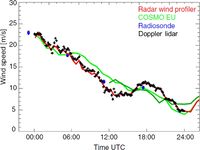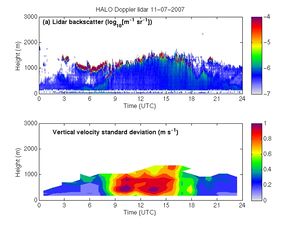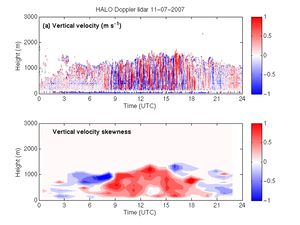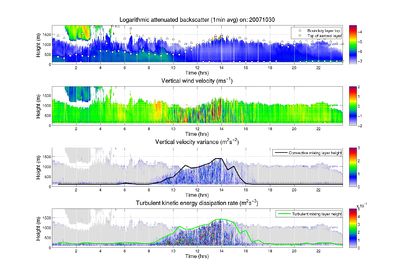DWL Operational Use
(Created page with "Portable autonomous Doppler lidar systems have been developed using new solid-state fibre-optic technology using coherent heterodyne detection to derive the Doppler shift of a...") |
Latest revision as of 02:20, 23 November 2013
Portable autonomous Doppler lidar systems have been developed using new solid-state fibre-optic technology using coherent heterodyne detection to derive the Doppler shift of atmospheric tracers (aerosol). Two implementations are available for these robust and low-powered systems: pulsed, and continuous-wave (CW). Pulsed systems are similar to ceilometers and other pulsed lidar systems, using the time of delay to provide the range information. Minimum range is typically 50-90 m, with maximum range varying from 0.2-10 km. CW systems adjust the focus of the telescope to provide the range information; hence these are most suitable for close range operation, typically from 10-300 m. Both implementations operate at very high pulse rates and average many pulses to achieve the required sensitivity. Due to the instrument design, there is no telescope overlap issue. The fibre optic design allows a high degree of flexibility, and these instruments are available in a number of guises: vertical stare only, full all-sky scanning capability, scan within a conical zone, or optimised for winds only. Doppler lidar systems which specialise in vertical profiles of horizontal wind obtain this by means of ‘Doppler Beam Swinging’, as is done for Wind Profilers, or use a conical VAD (Vertical-Azimuth-Display) scan. Wind profiles are restricted to regions where there is sufficient aerosol to provide a good signal, and in practice, this limits observations to within the boundary layer. When operated at vertical incidence, Doppler lidars exploit the return from aerosol particles to detect convective motions and the evolution of the mixing height. Turbulence characteristics can be derived from the rate of fluctuations of the vertical velocity. Note that the signal is attenuated by liquid clouds in the same manner as for other lidars.
[edit] 1 Calibration, Accuracy, Sensitivity and Maintenace
The backscatter coefficient can be calibrated in the same way as ceilometers (Westbrook et al., 2010). Doppler velocity is self-calibrating in the ‘noise’ and biases can be diagnosed with tests using hard targets. The accuracy of the radial velocity measurements depends on the signal to noise ratio and is typically much better than 0.5 m s-1; less than the representativity error of radio sondes. A combination of the wavelength used, and the heterodyne nature of the system, means that Doppler lidars are insensitive to daylight. Doppler lidars need minimal maintenance and experience is that they are very reliable.
[edit] 2 Original contributions made by EG-CLIMET action
| Evaluation
A side by side comparison over several weeks of wind profilers, sondes and Doppler lidars demonstrated that lidar horizontal winds were accurate to 0.2 m s-1 and 2 deg in direction. |
|
| Dissipation rate
The dissipation rate of turbulent kinetic energy within the boundary layer can be derived at high temporal and spatial resolution. Top panel displays attenuated backscatter coefficient from an urban site in London, UK, over a 24-hr period. Lower panel displays dissipation rate for the same period. |
|
| Boundary layer characteristics
The skewness and standard deviation of the vertical velocity measurements are excellent indicators of dynamical processes in the boundary layer. Standard deviation (top panel) indicates the intensity in the turbulent regions, while the skewness (lower panel) can be used to diagnose the source of turbulence; positive skewness arises from surface-driven convection, whereas negative skewness can indicate cloud-top driven turbulent processes. |
|
| Boundary layer height
Velocity variance, and dissipation rate can be used to identify the mixing-level height, which is the region of the boundary layer in constant contact with the surface. |





